 |
Consequences of Vatican II
A Charismatic Weekend at Steubenville
'Fusion Catholicism'
John Vennari
It was Saturday night at Franciscan University of Steubenville and all around the gymnasium, bodies were dropping to the floor. Luis Entrialgo, a married lay-deacon from Cuba, had just concluded a Protestant-styled “healing” service, and the slain-in-the-spirit session immediately followed. Loud music throbbed in hypnotic rhythm from the rock’n’roll “worship band”, lay-people laid hands on other lay-people, limp bodies fell backwards ending face-up on the floor, participants stepped around bodies to make their way down side aisles, a priest prayed in “tongues” over the microphone, “sha-na-la-sha-na-la-sha-na-la-sha-na-la, sha-na-la, thank You, Jesus!” It was the grand finale of the day.
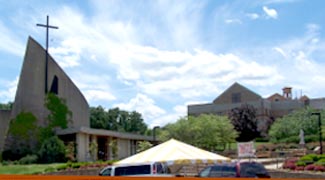
The Chapel, University of Steubenville campus
Photos by John Vennari |
Entitled “Transformed from Glory to Glory”, and held on June 9-11, it was the 24th Annual Catholic Charismatic Conference held at the famous Franciscan University. Speakers included Ralph Martin, Bert Ghezzi, Al Mansfield, Mark Nehrbas, Dr. Joanne Storm, Deacon Luis Entrialgo, Father John Gordon, Father Michael Scanlan and others.
I had attended Charismatic conferences in the past; most notably the 30th Anniversary Charismatic conference in Pittsburgh, June 1997, and Celebrate Jesus 2000, a “Catholic” conference top-heavy with Protestant Preachers in St. Louis in June, 2000. These weekends were riotous pep-rally, rock’n’roll romps that included Protestants preaching to a predominantly Catholic audience; bishops, priests, religious and laity dancing around on stage to “Christian” pop-music; and “Holy Laughter” sessions with Charismatics barking like dogs, rolling on the floor, screaming and laughing hysterically — all under the supposed operation of the Holy Ghost. In fact, Protestant preachers from the “Holy Laughter” sect were invited speakers at the year 2000 conference.
The 1997 and 2000 events both were held in large sports stadiums, and both organized by Franciscan University at Steubenville. I wrote my observations of these conferences in Catholic Family News at the time, which were published as the book Close-ups of the Charismatic Movement.[1]
1. Close-ups of the Charismatic Movement, J. Vennari [Los Angeles: Tradition in Action, 2002]. The book also includes a section on the revolutionary Leon Joseph Cardinal Suenens, one of the most radical prelates of the 20th Century who was the Charismatic movement’s zealous advocate and Cardinal-Protector. Cardinal Suenens is also famous for publicly opposing Humanae Vitae and destroying (“modernizing”) Convent life through his appalling book, The Nun in the World. (www.cfnews.org/CharBk.htm)
Though there was much to see, learn and weep over at the 1997 and 2000 conferences, I knew that no study of Catholic Pentecostalism would be complete without visiting the Mecca, the Mother-Church of Catholic-Charismaticism in the United States: Franciscan University of Steubenville. When I learned of the Charismatic weekend slated for June 2006, I knew I finally had to take the plunge. I purchased my ticket and arrived at the Steubenville campus late Friday afternoon.
Sunday afternoon found me weary and relieved the ordeal was over.
Fusion Catholicism
The Catholic Charismatic Movement is a clumsy, paint-by-numbers knock-off of Protestant Pentecostalism. It is a movement for Catholics who wish to remain Catholic while acting as Protestant as possible. Rooted in an unstable and embarrassing emotionalism, the Charismatic Movement displays a presumption regarding extraordinary phenomena that defies Catholicism’s 2000-year teaching on the discernment of spirits.

A weekend of Pentacostal and Catholic elements |
Any sober Catholic attending the 1997 and 2000 Charismatic conferences would recognize this at once. But the Steubenville weekend was a bit different. This particular conference ran the Catholic saints as its theme, and much of what was said by various speakers was doctrinally sound and even edifying. These positive aspects, however, were coupled with Pentecostal rollicks. One often felt pulled in two opposing directions at once.
In short, Steubenville has perfected a new synthesis of conservative Catholicism on the one hand, and Protestant, pep-rally Pentecostalism on the other. It is fusion Catholicism — Catholicism alloyed with non-Catholic elements. As such, it defies the command of the Athanasian Creed to hold the Catholic Faith “integral and inviolate”. This will become clear as we proceed through the conference.
Friday night
Franciscan University of Steubenville is a beautiful campus of rolling hills, tasteful landscaping, and, for the most part, handsome architecture. The conference was held on campus at the Finnegan Fieldhouse, a cleverly designed gymnasium that doubles as a conference center. From the outside, it looks more like a church than Steubenville’s signature chapel, which kind of resembles an eccentric Hershey Kiss. I took my place in the audience as the rock’n’pop worship band detonated their upbeat “Gathering music”. Happy Charismatics were already on their feet, swaying to the music, singing along, some bopping up and down and clapping hands.
The crowd of nearly 1000 was predominantly elderly and middle-aged. Clean-cut Steubenville students in matching yellow shirts helped with the running of the event. Some of them too bopped to the music.
Steubenville’s Mark Nehrbas was Master of Revels for the weekend. He greeted the crowd who responded with enthusiastic applause. He then brought the “team” on-stage, the speakers for the weekend, and quickly introduced them one by one. He then introduced each member of the worship band, and made a few comments about Steubenville being a spirit-filled institution. These formalities concluded, we were now ready for “worship”.
“Praise and worship”
The so-called “Praise and Worship” session at this Steubenville gathering was nothing that Pope Pius X, Pius XI, Pius XII, Padre Pio, Saint Therese of Lisieux, Saint Dominic Savio or any other canonized saint would recognize or accept as Catholic. It is a worship session based not on Catholic teaching and tradition, but on a techno-pop, Protestant model. The physical setting of the conference itself was patterned on the contemporary Protestant construct. The stage is at the center with a podium slightly off-center, to the audience’s left is the obligatory rock’n’pop band. This one consisted of two plug-in acoustic guitars, electric bass, electric keyboard, violin, full drums set, and two extra singers. On each side of the stage, large television screens hung from the ceiling to project the lyrics of the songs to the audience.
At former Charismatic binges I’ve attended, the musicians went under the name “music ministry”. This group shunned that title, calling themselves a “worship band”. It was headed by Bob Rice on guitar, a young teacher at Steubenville. The rest were Steubenville students, except for Ralph Martin’s daughter on the electric keyboard.
A brief word about the music. Each time I attend one of these Charismatic events, I find that for the most part, the music is a different collection from the previous one. At the 1997 bash, there was one assortment of songs, especially a tune called Let the Fire Fall played over and over again. At Celebrate Jesus 2000, there was yet another collection, the big number played repeatedly being Days of Elijah.
At this latest bash, I was confronted with yet another assortment of thumping, sensual “Christian-pop” tunes. Perhaps this constant change is due to the fact that “Christian Rock” has pretty much gone the way of pop music. Christian Rock “artists” continue to write songs and release CDs. Billboard charts their sales and reports on their concerts. The CDs win Grammys. As Christian Rock is now an industry unto itself, the assortment is vast and the old tunes will be replaced by the new.
Rockin’ with the Cross
Steubenville’s worship band officially kicked off the “Praise and Worship” session – as it is called in the conference program – with Now is the Time to Worship, written by Brian Doerksen, a Protestant “Worship leader”. Those in the audience sprang to their feet and joined in: some with hands raised in Pentecostal manner, some grooving in place, some clapping hands. The emotion of the audience intensified as the rock music intensified, and diminished as the music diminished.
The “team” on stage: Father Michael Scanlon, Father John Gordon, Dr. Joanne Storm, Sister Sarah Burdick, Sister Katherine Caldwell, Ralph Martin, Bert Ghezzi, Al Mansfield and Mark Nehrbas, sang along, raised hands in Pentecostal fashion; some sang with eyes clenched shut as if in the grip of some deep emotion. It reminded me more of the 700 Club than anything recognizably Catholic.
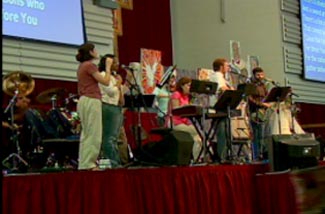 |
The band revving up for a weekend of Protestant songs |
In fact, every song the worship band played Friday evening was a Protestant pop number written by a Protestant songwriter. I found every tune performed that night on the Protestant Rockin’ with the Cross website, a site designed to facilitate contemporary Protestant “Praise and Worship” sessions.
The Steubenville worship band churned out Blessed Be Your Name by Protestant Beth Redman, Lord I Give You My Heart by Protestant “music Pastor” Reuben Morgan; the high-powered Days of Elijah and Lion of Judah by Protestant Robin Mark; The Air I Breathe by Marie Barnett of the “Holy Laughter” Vineyard sect; Give us Clean Hearts by Protestant Charlie Hall; and other Protestant songs equally trendy. All were beat-driven, power-numbers that propelled the charismatic to his feet. The slower, sensual, throbbing pieces such as The Air I Breathe could have come straight from Whitney Houston or The Miami Sound Machine. All was worldly, earthy, profane.
At the conclusion of various numbers, the band would sustain the endings creating rumbling background noise, as is done by pop bands at rock concerts to drive the crowd into a frenzy. When this was done at Steubenville, members of the “team” would launch into a spontaneous “praise the Lord” session. All was executed in a Protestant manner: “Praise the Lord”; “Holy are You, Lord”, they would shout. The crowd went into its own spontaneous praise. This back and forth of music and ad-lib praise dragged on for forty minutes. The band closed with the upbeat Blessed be the Name of the Lord while the audience grooved. A middle-aged woman danced in the side aisles.
Mark Nehrbas brought the session to an emotional conclusion, yelling, “PRAISE GOD, PRAISE GOD”. The audience recognized the cue to join in and shouted in Protestant-style praise exhilaration. Then layman Nehrbas, with one arm raised high in the air as if imparting some Heavenly benediction, belted over the microphone: “Jesus there is no Name on earth like Yours, Your Name is above all Names, and it is our privilege and our joy to worship Your Holy Name, and we thank You and praise You for allowing us to come into Your throne room this night. All praise, honor and glory to You Lord Jesus Christ, and GOD’S PEOPLE SAID ...”, the audience screamed back “AMEN!”.
“Hallelujah! Praise God!”, shouted Nehrbas.
Bob Rice, the head of the worship band, then gave his testimony, or “Witness” (as the conference program called it) of his personal faith journey. This was followed by Charismatic Ralph Martin whose talk was entitled “Transformation in Christ: Wisdom from the Saints”, the content of which, for the most part, was rather good. It spoke of the need to renounce mortal and deliberate venial sin, the necessity of prayer, and contained edifying quotations from the saints. This is what I mean when I say that at this conference, there was the sense of being pulled in two opposing directions. It is the very nature of fusion Catholicism. It is also the nature of Modernism, as Pope Saint Pius X explained in Pascendi: on one page of the modernist’s book we find orthodox doctrine, on the next page, we find the thoughts of an agnostic. It goes in opposing directions at once.
“Accept Jesus as Lord and Savior”
After Martin’s lecture, Mark Nehrbas addressed the crowd, “I think this was not a talk of spiritual milk, but of meat. Amen?” Then, with the worship band wafting mood music in the background, he invited those in the crowd who had never done so before to stand up and publicly accept Jesus Christ as Lord and Savior. It was remarkably similar to the Oral Robert’s style “altar call”, and to the “altar call” enacted at Celebrate Jesus 2000 by “Holy Laughter” preacher Stephen Hill.
The baton was then passed to Steubenville’s Father John Gordon who took over the business with gusto. He commenced a non-stop exhortation to commit oneself to Jesus, doing so while prancing back and forth on the stage with a cordless microphone, sometimes lapsing into “tongue” prayer: Sha-na-la-sha-na-la-sha-na-la.
Finally it was time to “make the commitment”, or as Protestants call this procedure, to “get saved”. Father Gordon launched into a repeat-after-me, semi-improvised formula: “Jesus, I ask You to be my Savior”. The audience responded, “Jesus, I ask You to be my Savior”, Father Gordon continued, “I am a sinner,” the audience echoed, “I am a sinner”.
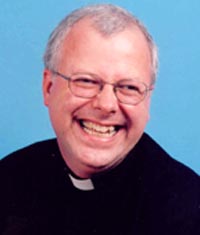
Steubenville's Fr. Gordon led the Commitment Session |
Father Gordon: “I repent of all my sins”.
Audience: “I repent of all my sins.”
“I need You to be my Savior,” audience repeats;
“For I am a sinner”, audience repeats,
“I renounce all wrong doing”, audience repeats.
This continued with the audience echoing each of the following short sentences,
“How grateful I am to You;
“How fully I need You;
“Jesus, my Savior;
“I ask You to be my Lord;
“I need You to be my Lord;
“Jesus Christ Lord and Savior.”
Father Gordon and the audience bantered along in this manner until finally, the “commitment” session concluded with an eruption of sustained applause.
As the clapping and cheering persisted, Father Gordon shouted in celebratory tone, “REMEMBER THIS DAY! HEAR THE CHURCH SUPPORT YOU! HEAR THE CHURCH BEHIND YOU! PRAISE GOD! PRAISE GOD! PRAISE GOD!” (sustained applause as the newly committed returned to their seats.)
Father Gordon then invited those who had previously committed themselves to Jesus as Lord and Savior to stand up and do it again, and a similar ritual played out, though those committing themselves did so by standing in place rather than walking to the front.
Father Gordon continued his non-stop patter and at one point told the people to cry out:, “JESUS MY SAVIOR”, the audience reverberated “JESUS MY SAVIOR”, Father Gordon bellowed, “HOW I NEED YOU AND I WANT YOU”. The audience followed suit.
Father Gordon went on, “THANK YOU JESUS FOR BEING MY SAVIOR, SAVE ME JESUS, I NEED YOU JESUS, I CAN’T DO IT WITHOUT YOU JESUS. YOU ARE MY SAVIOR, PRAISE YOU JESUS, PRAISE YOU JESUS, PRAISE YOU JESUS, PRAISE YOU JESUS.” While this was going on, the background mood music swelled and crashed into another performance of the throbbing, Lord I Give You My Heart. Father Gordon, still full of fuel, pattered on over top the music, “Blessed is the Lord Our God, Hallelujah, Lord. Blessed is the name of the Lord”. The “team” on stage sang along. All was thundering high emotion.
The worship band finally terminated their piece, the audience cheered, there was more, “Thank you Lord, praise God” patter from Mark Nehrbas overtop the applause. Each speaker then gave a précis of the Saturday workshop he or she was to conduct, and the day finally drew to a close.
Debauched Catholicism
While watching the noisy “commit your life to Jesus” session, I kept asking myself: what is the point? Catholics have never engaged in such a degrading spectacle before. Why do it at all? It is easy to understand why Protestants put themselves through this exercise, since for many of them, it is the one and only means of becoming “saved”.
Most evangelical and Pentecostal Protestants do not believe that a Christian is “born again” when baptized. Rather, a man or woman is not “saved”, does not become a “Christian,” until he makes a personal commitment to Jesus Christ. It is the standard “get saved” process one sees in Protestant tracts. I acknowledge I am a sinner, I acknowledge my need for Jesus, and I commit myself to Jesus by accepting Him as my personal Lord and Savior. Thus, according to this system, even if you are a baptized Roman Catholic, you are still not a “Christian” until you make this personal commitment to Jesus.
I remember my heartbreak when a cradle-Catholic friend told me that he was now a “Christian”. He was beaming with enthusiasm, so happy to realize he had never been a Christian before, and now he was. Here was a man who, due to this newly found “salvation”, walked away from the true Faith, abandoned Holy Mass and the sacraments, and now embraced a heretical creed. He was objectively living a mortal sin against the First Commandment. Yet he displayed a similar kind of effected jubilation, the same effervescent toothpaste smile, that same so-called “alive in Jesus” mannerism that I saw from many at this latest Charismatic conference — which proves that outward appearances of being supposedly “full of the Spirit” mean nothing.
This dear friend of mine had been baptized and raised Catholic, so indeed, he had been a Christian since the day of his Christening. But at one point in his life, he attended one of those noisome evangelical businessman’s gatherings where he was told that his baptism really didn’t matter. His Catholicism didn’t matter. No, if he wanted to be a “Christian”, there was no other way to do it but to accept Jesus as Lord and Savior. And as he was a product of post-Vatican II Catholic education, he fell for it in a flash.
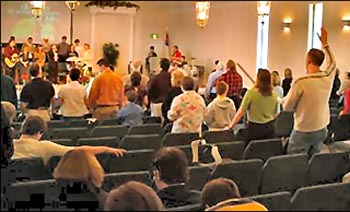
Catholic witness ceremonies increasingly look like Protestant spirit movements, above |
The Protestant formula of being “saved” by accepting Jesus as one’s personal savior is based on a rejection of the sacrament of Baptism as the means established by Christ to cleanse original sin and fill the soul with sanctifying grace. It is by this means alone that we receive the Divine Life of the Blessed Trinity in our souls. This is the central point of doctrine denied by the Protestant’s getting “saved” by merely accepting Jesus as Lord and Savior.
So, if imitation is the sincerest form of flattery, why does the Steubenville Catholic imitate a Protestant practice based on rejection of bedrock tenets of the Catholic Faith? What good does publicly accepting “Jesus as Lord and Savior” when one is already in the state of grace? It is a shallow, emotional spectacle found nowhere in our sacred heritage. One can only try to imagine noble Catholics such as G.K. Chesterton, Hilaire Belloc or Emperor Karl of Austria submitting to this gushing “commit your life to Jesus” parody.
In fact, the Catholic Church already has a public ceremony to “re-commit one’s life to Jesus”, if you will, it is the “Renewal of Baptismal Promises” enacted on Holy Saturday. This dignified and noble ceremony is steeped in Catholic tradition and symbolism. It is not, as were the Steubenville antics, a cheap imitation of Jim and Tammy Baker emotionalism. And if a baptized soul falls from grace, then he must seek the Sacrament of Confession, a point of doctrine that the Steubenville species does not appear to deny (there were confessions going on throughout the conference weekend and the attendees were encouraged to go).
Again, what we see in all this is fusion Catholicism: Catholicism admixtured with Protestant elements that denigrate the Catholic Faith, and serves to ennoble a Protestant practice that denies the very words of Our Lord Jesus Christ in His institution of the Sacraments.[2]
Blessed Pope Pius IX, as with all the Popes up to Vatican II, rightly recognized Protestantism in all its forms as “a revolt against God.”[3] Pius IX also, in his magnificent Syllabus of Errors, solemnly condemned the error that “Protestantism is nothing more than another form of the same true Christian religion”,[4] an error on which “Catholic Pentecostalism” is based.[5] What went on at this Steubenville weekend — which was steeped to the gills in Protestant spirit — was by no means an explosive outpouring of the Holy Spirit. On the contrary, all indications point to the spirit of the underworld at work.
2. For example, for Our Lord’s institution of the Sacrament of Baptism, the Holy Eucharist, and Confession, see John 3:5; Matthew 28:19; Matthew 26:27-28; Mark 14:22-24; Luke 22:19-20; 1 Cor. 11:23-26; John 6:54-59; John 20:21-23. See also Council of Trent, On the Sacraments, Canon I (found on page 2 of this issue).
3. Blessed Pope Pius IX identified Protestantism in all its forms as “a revolt against God, it being an attempt to substitute a human for a divine authority, a declaration of the creature’s independence from God.” Quoted from Father Michael Müller, C.SS.R., The Catholic Dogma [New York: Benzinger Brothers, 1888], p. 43-4.
4. Syllabus of Errors, Condemned Proposition # 18.
5. See companion piece, “‘Catholic’ Pentecostalism: Grown in the Garden of Heresy”, J. Vennari, page 3 of the August 2006 issue of Catholic Family News.
Saturday
In 1974, in a scathing criticism of the Charismatic movement, the staunchly orthodox Archbishop Dwyer of the United States said, “We regard it bluntly as one of the most dangerous trends in the Church in our time, closely allied in spirit with other disruptive and divisive movements; threatening grave harm to unity and damage to countless souls.”[6]
Joseph Fitcher, in his 1974 book The Catholic Cult of the Paraclete, mentioned that some Catholic prelates were “worried about the Protestant influence on their people” due to Pentecostalism. Fitcher quoted Bishop Joseph McKinney’s worry about Catholics being “misled and not being firmly grounded in theology”.[7]
6. Dwyer’s criticism appeared in an interview published in the National Catholic Register, July 21, 1974 and is cited from Joseph Fitcher’s The Catholic Cult of the Paraclete, Sheed and Ward, Inc. New York, 1974, p. 40
7. Op. cit. page 40. Original quote from Bishop Joseph McKinney appeared in an interview published in New Covenant, September, 1971, pp. 10-16.
My weekend at Steubenville proved how correct were these good bishops’ concerns. This was especially evident during Saturday’s events. The day began with a short “Worship and Praise” session, with the same rock’n’pop music, the same emotionalism from the audience, the same Protestant-style “Praise God”, “Hallelujah”, “Praise the Lord” salvos from the podium. This was followed by two lectures. Al Mansfield spoke on “We Walk by Faith, Not By Sight”, telling the heartbreaking story of his New Orleans home being destroyed in Hurricane Katrina. In the process, he urged everyone, “do not leave here without getting baptized in the Holy Spirit.”
Then came Bert Ghezzi’s “The Transforming Power of the Sign of the Cross,” which was by and large a fine presentation. He explained the Catholic practice of making the Sign of the Cross, the history of this practice and what a holy and powerful sacramental it is.
This was followed by the 10:30 a.m. “Eucharistic Liturgy”, a Novus Ordo celebration full of rock’n’pop music. Some of the details of this liturgy will be recounted in a future installment.
We then arrived at the two afternoon workshop sessions: the first at 2:00, the second at 3:30. Each of the sessions had five workshops conducted simultaneously by various speakers. For the moment, I will only mention one of the workshops I attended. It was entitled “Forming Your Character With the Saints” conducted by Joanne Storm, Ph.D., a preppy and enthusiastic young lady who teaches Psychology at Steubenville. Though her manner of presentation may not be for everyone, the content of her speech was, for the most part, quite good. She listed a “Top 10 Characteristics” of the Saints that included: frequent use of confession; living a counter-cultural life; humility; devotion to the Eucharist and other points. Not mentioned on the Top 10, however, was devotion to Our Blessed Mother. I thought this a serious omission, though I do not in any way question Dr. Storm’s love of Our Lady.
During her presentation it occurred to me that there was another point the saints had in common. All of them became saints without a Pentecostal “baptism of the Holy Spirit”. All of them rose to heroic sanctity without attending rock’n’roll masses, without publicly “accepting Jesus as Lord and Savior” in the Protestant fashion, without adopting Protestant terminology and mannerisms. Her talk inadvertently demonstrated that the last thing one needs to become a saint is any participation in this new wave of Pentecostalism now infecting the Catholic Church.
In fact, every saint that Dr. Storm mentioned: Saint John Vianney, Saint Teresa of Avila; Saint Joan of Arc, Saint Elizabeth of Hungary, Saint John Bosco, would have run from that Steubenville conference screaming in horror at what was presented as “Catholic” to gullible participants. Worse, Saint Katherine Drexel of Philadelphia, who died in 1928, would have immediately recognized the Steubenville weekend for what it was: a high-decibel reincarnation of the revivalist, big-tent, store-front Protestant pentecostalism rampant in early 20th Century America.
Unholy “Holy Hour”
People often ask how I can stand to attend these rollicking events. I answer that I had been a professional musician studying jazz and classical guitar, and playing pop music in night clubs for five years. All those years desensitized me, so I don’t feel compelled to flee the room when the loud music ignites. I neither play nor listen to rock music any more, but I still know a rock concert when I see one, and I recognize these Charismatic weekends (as well as World Youth Day) as rock jamborees with a thin “Christian” veneer.
This does not mean that I find these events easy to endure. They are extremely taxing. By Saturday night, I was weary and looking for some sort of reprieve. So when I saw a “Holy Hour” scheduled for around 8:00 that night I had hoped that perhaps, after the non-stop noise of the day — the blasting rock’n’roll; bombastic “praise the Lord” sessions; continuous cheers from the audience; the Hindu-like buzz of orchestrated “prayer in tongues” — maybe, just maybe, we were actually going to have an hour of quiet.
I could not have been more mistaken.
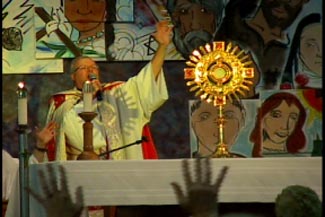
The Charistmatic "Holy Hour" at Steubenville
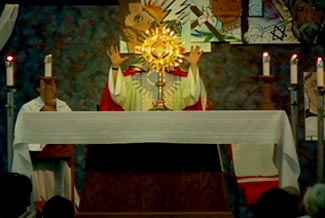 |
The “Holy Hour” was preceded by energetic “Gathering music” from the worship band. When I entered the gymnasium that evening, the band and audience were in full romp, doing a fast-paced “I Saw the Light” number. Those in the crowd grooved and clapped, a group of middle-aged women danced in the aisles up near the stage. This was followed by another upbeat crowd-pleaser about “The House of the Lord.”
Father Scanlon then spoke of the needs of Franciscan University of Steubenville; a student gave testimony at the podium of what a wonderful place he thought Steubenville to be. Father Scanlon returned to direct a collection for those who can not afford to send their youngsters to Steubenville. After this, the “Praise and Worship Holy Hour” commenced.
It began with yet more rock’n’pop music, a repeat of The Days of Elijah. Then there was a brief period where those on the “team” either read a passage of Scripture or enacted an ad-lib prayer. The band then kicked in to Prepare the Way, a Protestant pop-tune found on the Rockin’ with the Cross website. It was to this rock’n’pop music that Father John Gordon made his dramatic entrance into the hall with the Blessed Sacrament in a monstrance. The “Holy Hour” was now underway.
The lights in the hall were dimmed, and a golden-yellow spotlight perched on a small loft in the back of the hall, trained on the monstrance held aloft by Father Gordon. Three young men in white robes: two holding candles and one walking backwards incensing the monstrance led the procession. All the while, the hall throbbed with the worship band’s rhythms. Fusion Catholicism again.
The band then kicked into a slow, pulsating rock number written by Protestant Michael W. Smith called Agnus Dei and found on the Rockin’ with the Cross website.
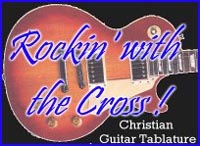
All the adoration music is on the Protestant Rockin' with the Cross website |
The heavy beat, sustained singing and powerful dynamics sent a sensation throughout the crowd that intensified when Father Gordon finally placed the monstrance on the Novus Ordo table-altar. Father Gordon incensed the monstrance from behind, then stood behind the monstrance, one arm raised and the other holding the microphone to his lips, and started to belt out, “Holy are you, Lord. Blessed is our Lord God, Worthy, worthy is the Lord,” overtop the blazing rock tune. The band kicked up volume and energy, singers improvised overtop the music. Father Gordon continued to cry out “worthy, worthy, worthy, Lord”. Father Gordon also broke into tongue prayer over the crashing cymbals and pounding music; “shamana shamana shamana shamana shamana.” It was one of the most grotesque sights I ever witnessed.
The music grew quiet, a din of “tongue” prayer continued. More pop music was set off, this time We Fall Down by Protestant Chris Tomlin and found, you guessed it, on the Rockin’ with the Cross website.
In fact, with the exception of about two hymns, every song performed at the “Holy Hour” was a Protestant pop-tune written by a Protestant and found on the Protestant Rockin’ with the Cross website. One can only imagine how Pope Saint Pius X would have reacted to this profanity.
Defiance of age-old Magisterium
Pope Saint Pius X, in conformity with all the Popes before him, reiterated the age-old truth that only Sacred Music is lawful for Church and for Catholic worship. He obviously considered this of paramount importance, for he was only three months in office when he issued the magnificent Instruction on Sacred Music, Tra le Sollecitudini. Pius decreed:
“Nothing should have place, therefore, in the temple calculated to disturb or even merely to diminish the piety and devotion of the faithful, nothing that may give reasonable cause for disgust or scandal, nothing, above all, which directly offends the decorum and sanctity of the sacred functions and is thus unworthy of the House of Prayer and of the majesty of God.”
Saint Pius X insisted that Sacred Music must be composed of three elements: it must be holy; it must be true art; and it must be universal.
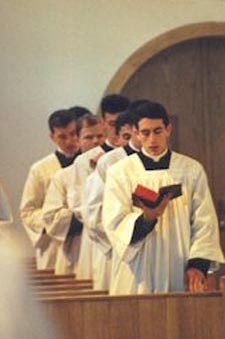
St. Pius held up Gregorian chant as the ideal church music |
As for the element of holiness, Saint Pius X explained that Sacred Music “must be holy, and must, therefore, exclude all profanity not only in itself, but in the manner of those who execute it.” (Speaking of “those who execute it”, the worship band members dressed in an off-the-street manner: casual attire, girls in dungaree trousers, for both Saturday Mass and the “Holy Hour”.[8] The fault here must be placed primarily with the “spirit filled” clergy at Steubenville for their dereliction of duty, not teaching youngsters in their charge about proper attire for church functions. The audience was likewise slovenly dressed for these Saturday events).
Pope St. Pius X railed against worldly music in church: “... the Church may contain nothing profane [and must] be free from reminiscences of motifs adopted in theaters, and be not fashioned in their external forms after that manner of profane pieces.” Any new compositions must be of “Sobriety and gravity, that they are in no way unworthy of the liturgical functions.”
Saint Pius X held up Gregorian Chant as the infallible measuring rod by which all church music must be gauged:
“... Gregorian Chant has always been regarded as the supreme model for Sacred Music, so that it is fully legitimate to lay down the following rule: the more closely a composition for church approaches in its movement, inspiration and savor the Gregorian form, the more sacred and liturgical it becomes: and the more out of harmony it is with that supreme model, the less worthy it is of the temple.”[9]
8. I arrived after the Sunday Mass the next day, and the crowd did not appear to be dressed all that differently from Saturday.
9. Pope Saint Pius X, Motu Proprio Tra le Sollecitudini: Instruction on Sacred Music, November 22, 1902. (Emphasis added on all quotes). For more, see “Pope St. Pius X’s Motu Proprio: Tra le Sollecitudini,” Eight Part Series by Patrick Brill, Ph.D. (From CFN, reprint #2045, $5.00US)
Few forms of music could be further from the Gregorian Chant model than “Christian rock” written by modern Protestant songwriters for Protestant services. It does not say much for the “Christian rock” played at Steubenville when I observe that the only forms “less worthy of the temple” would be rap, punk and heavy metal.
In fact, even today’s Pope Benedict XVI, who is progressive in other areas, has recently expressed his displeasure at pop music at church functions. At a June 27 concert conducted by Domenico Bartolucci, the director of music at the Sistine Chapel, Benedict XVI said that the only suitable music for Catholic worship was the traditional type. “It is possible to modernize holy music,” said Benedict XVI, “but it should not happen outside the traditional path of Gregorian chants or sacred polyphonic choral music.”[10]
Rock music is disordered by its very nature, no matter what lyrics are layered on top of it. Rock’s beat-driven structure is de-signed to inflame emotions, inflame the lower passions. Even The Rolling Stones’ Keith Richards admitted, “Rock music is music for the neck down.”[11]
10. “The Pope Wants Pop Music Banned from Churches”, Hindustan Times, June 27, 2006. Next month, we will contrast this with Pope Benedict XVI’s reportedly positive attitude toward the Charismatic movement, and ask how the two can possibly go together.
11. “Elefant: The Black Magic Show”, Stylus Magazine. www.stylusmagaz ine.com/review.php?ID=3972 (rock website).
Rock music is a defining element of the modern pop-culture antithetical to Catholicism. Oddly enough, though Dr. Storm had probably not considered this, if Charismatics would take to heart the full implications of Dr. Storm’s call to be “counter-cultural”, the first thing they would have to abandon is the “Christian rock” to which they are addicted. “Christian rock” is an illegitimate compromise with a form of music intrinsically disordered. According to the perennial norms reiterated by Pope Saint Pius X (and according to common sense), “Christian rock” is a profanity that deserves no place in any Catholic function whatsoever.
Steubenville’s adoption of this profane and earthy music is one of the many demonstrations that their emotion-driven Pentecostalism is not operating under the Holy Spirit, but under a spirit alien to Catholicism, alien to the Saints, alien to Pope Saint Pius X and all of his predecessors.
“Holy Hour” or “holy roller”?
Back to the rock’n’roll Holy Hour at Steubenville.
After the session already mentioned, Father Gordon gave a brief homily that was, in the Charismatic fashion, interspersed with applause from the audience at least five times. Then the Procession began.
The worship band kicked into one of its throbbing Protestant numbers, Father Gordon came down from the stage with the monstrance and began to process slowly throughout the hall. Again, the three young men in white robes, two acolytes and an incensor, went before him. The lights were low, the golden-yellow spotlight illumined the monstrance that Father Gordon held aloft, he moved at a snail’s-pace slowly blessing the crowd with the monstrance as he went along. Father Gordon’s movements here were slow and even regal, in sharp contrast to rock’n’pop music enveloping the hall.
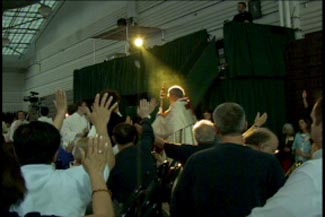
Fr. Gordon with the monstrance leaves the stage and processes out with rock music blaring and arms waving
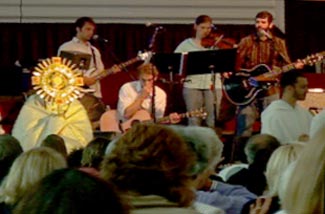 |
Now the band was blasting Better One Day in Your Court by Protestant Mark Redman. Some in the crowd began to stand and pray with arms raised. The entire procession lasted about 50 minutes. The worship band went from one Rockin’ with the Cross tune to another: The Air I Breathe by Protestant Marie Barnett; Enough by Protestants Chris Tomlin and Louie Giglio; Dwell by Protestant Casey Corum and distributed by the “Holy Laughter” Vineyard sect.
And as for my hour of quiet? Well, the reader sees what a vain desire that was. We had constant noise for the entire hour. By the end of the procession, many Charismatics were up on their feet, praying with arms extended in the air.
Father Gordon returned to the stage and placed the monstrance on the altar-table. Then, as if someone suddenly switched a radio station, the Tantum Ergo in Latin started to emanate from the stage. This Catholic hymn was a head-on collision with everything that had been performed previously. “You have given us bread from Heaven,” chanted Father Gordon, followed by the response in English. He blessed the audience, the crowd sang Holy God We Praise Thy Name (supported by electric piano), Father Gordon processed with monstrance out of the hall. Then came a final shake-the-walls rocker, the title of which I could not find. The worship band brought the tune to a dramatic close as the audience cheered. The grotesque “Holy Hour” was complete.
Youth sessions even worse
There is more to observe from this Charismatic weekend that will have to wait until next month. It should be noted that Steubenville youth rallies, which host tens of thousands of Catholic teen-agers from high schools around the country, are conducted according to the same techno-Protestant approach to Catholicism, wherein teens are bombarded by rock’n’pop praise music, urged to “commit their lives to Jesus” in the Protestant fashion, and encouraged to be “baptized in the Holy Spirit”.[12] Worse, these events sometimes include the supremely ridiculous rappin’ priest, Father Stan Fortuna.
12. I saw a similar youth fiasco at Celebrate Jesus 2000 organized by Steubenville University.
A 15-year-old boy of my acquaintance said he attended a high school weekend at Steubenville University wherein teenagers were dropping to the floor “slain in the spirit” to thumping rock music. “We were packed in the hall so tightly that we could barely move,” he said. “There were young people collapsing all around me. I couldn’t wait to get out of there. I was scared to death.”
Yet due to the severe confusion in the Church brought about by Vatican II, a confusion that suddenly blesses what the Church always condemned, Franciscan University of Steubenville enjoys the reputation as one of North America’s leading bastions of Catholic orthodoxy.
This confusion extends to the dear souls who attended the Charismatic weekend. Most Charismatics at this conference, I would guess, are kind, generous, well-meaning people who have been misled, due to what Sister Lucy of Fatima called the diabolic disorientation of those who occupy places of responsibility in the Church.
One last stop
On Sunday just before leaving the June conference, I stopped at the University book store, a place where fusion Catholicism flourished. The collection of materials was both Catholic and “Charismatic”, both pre-Conciliar and post-Conciliar.
Once again, the most notable element was noise. Blasting through the store’s loudspeakers was an even harder-edge “Christian rock” than what was performed throughout the weekend. It was a sampling from the many “Christian Rock” CD’s for sale at the spirit-filled university.
This article was first published in Catholic Family News, August 2006

Posted August 14, 2006

Related Topics of Interest
 Charismatics, Devils and Modernists Charismatics, Devils and Modernists
 What’s Wrong with World Youth Day? What’s Wrong with World Youth Day?
 The Catholic Charismatic Movement is Not Catholic The Catholic Charismatic Movement is Not Catholic
 The Subjectivist Morals of Mr. Karl Keating The Subjectivist Morals of Mr. Karl Keating
 Are There Exaggerations in Our Pictures of the Week? Are There Exaggerations in Our Pictures of the Week?
 The Canonization of Wojtyla, the Moral-Free Pope The Canonization of Wojtyla, the Moral-Free Pope
 Traditionalist Issues Traditionalist Issues
 Crisis in Ecumenism Crisis in Ecumenism
 From Pentacostalism to Apostasy From Pentacostalism to Apostasy

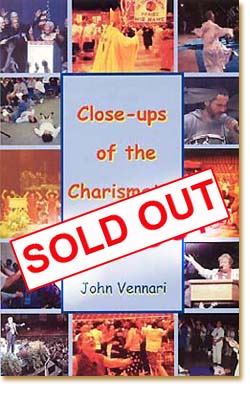
|
Vatican II | Hot Topics | Home | Books | CDs | Search | Contact Us | Donate

© 2002-
Tradition in Action, Inc. All Rights Reserved
|
 |
|